light SKODA ROOMSTER 2006 1.G Workshop Manual
[x] Cancel search | Manufacturer: SKODA, Model Year: 2006, Model line: ROOMSTER, Model: SKODA ROOMSTER 2006 1.GPages: 274, PDF Size: 48.64 MB
Page 67 of 274
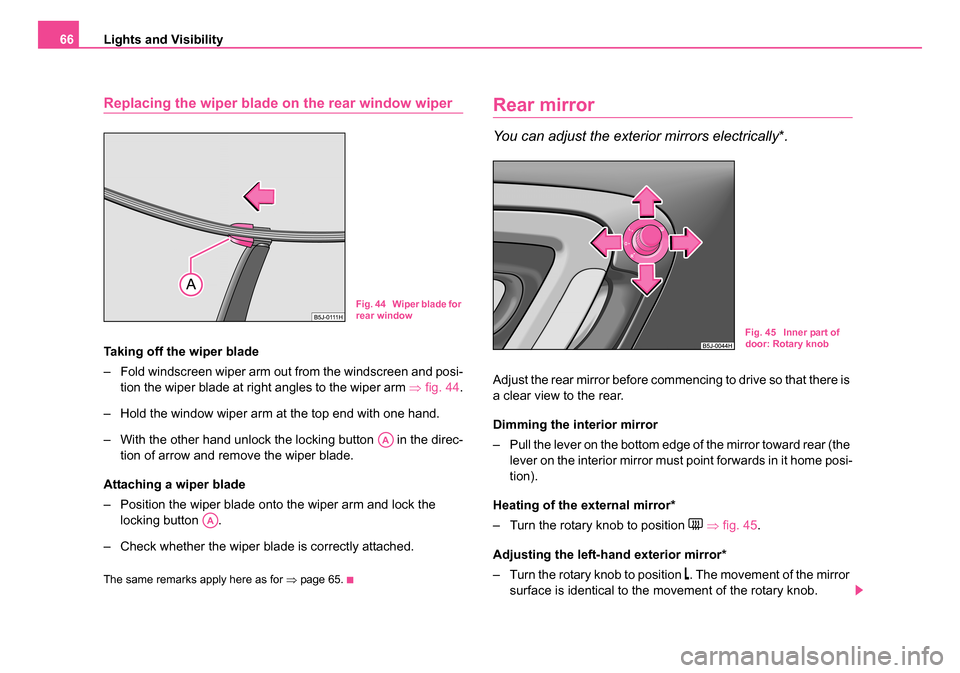
Lights and Visibility
66
Replacing the wiper blade on the rear window wiper
Taking off the wiper blade
– Fold windscreen wiper arm out from the windscreen and posi-
tion the wiper blade at right angles to the wiper arm ⇒fig. 44 .
– Hold the window wiper arm at the top end with one hand.
– With the other hand unlock the locking button in the direc- tion of arrow and remove the wiper blade.
Attaching a wiper blade
– Position the wiper blade onto the wiper arm and lock the locking button .
– Check whether the wiper blade is correctly attached.
The same remarks apply here as for ⇒page 65.
Rear mirror
You can adjust the exterior mirrors electrically*.
Adjust the rear mirror before commencing to drive so that there is
a clear view to the rear.
Dimming the interior mirror
– Pull the lever on the bottom edge of the mirror toward rear (the
lever on the interior mirror must point forwards in it home posi-
tion).
Heating of the external mirror*
– Turn the rotary knob to position
⇒ fig. 45 .
Adjusting the left-h and exterior mirror*
– Turn the rotary knob to position
. The movement of the mirror
surface is identical to the movement of the rotary knob.
Fig. 44 Wiper blade for
rear window
AA
AA
Fig. 45 Inner part of
door: Rotary knob
NKO 20 A05.book Page 66 Wednesday, June 21, 2006 1:42 PM
Page 68 of 274
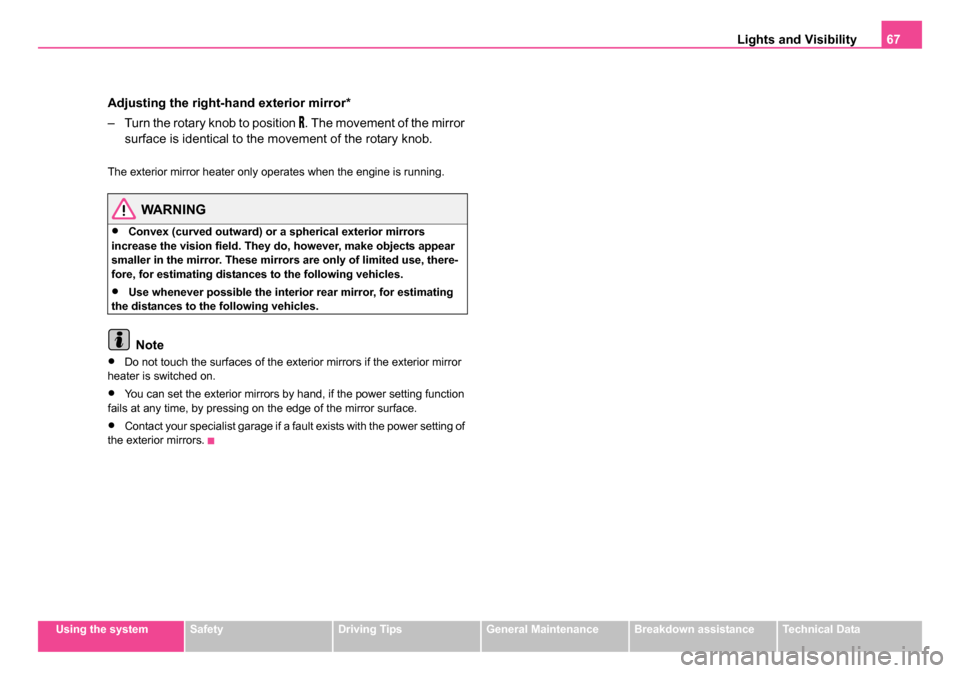
Lights and Visibility67
Using the systemSafetyDriving TipsGeneral MaintenanceBreakdown assistanceTechnical Data
Adjusting the right-hand exterior mirror*
– Turn the rotary knob to position
. The movement of the mirror
surface is identical to the movement of the rotary knob.
The exterior mirror heater only operates when the engine is running.
WARNING
•Convex (curved outward) or a spherical exterior mirrors
increase the vision field. They do, however, make objects appear
smaller in the mirror. These mirror s are only of limited use, there-
fore, for estimating distances to the following vehicles.
•Use whenever possible the interior rear mirror, for estimating
the distances to the following vehicles.
Note
•Do not touch the surfaces of the exterior mirrors if the exterior mirror
heater is switched on.
•You can set the exterior mirrors by hand, if the power setting function
fails at any time, by pressing on the edge of the mirror surface.
•Contact your specialist garage if a fault exists with the power setting of
the exterior mirrors.
NKO 20 A05.book Page 67 Wednesday, June 21, 2006 1:42 PM
Page 70 of 274
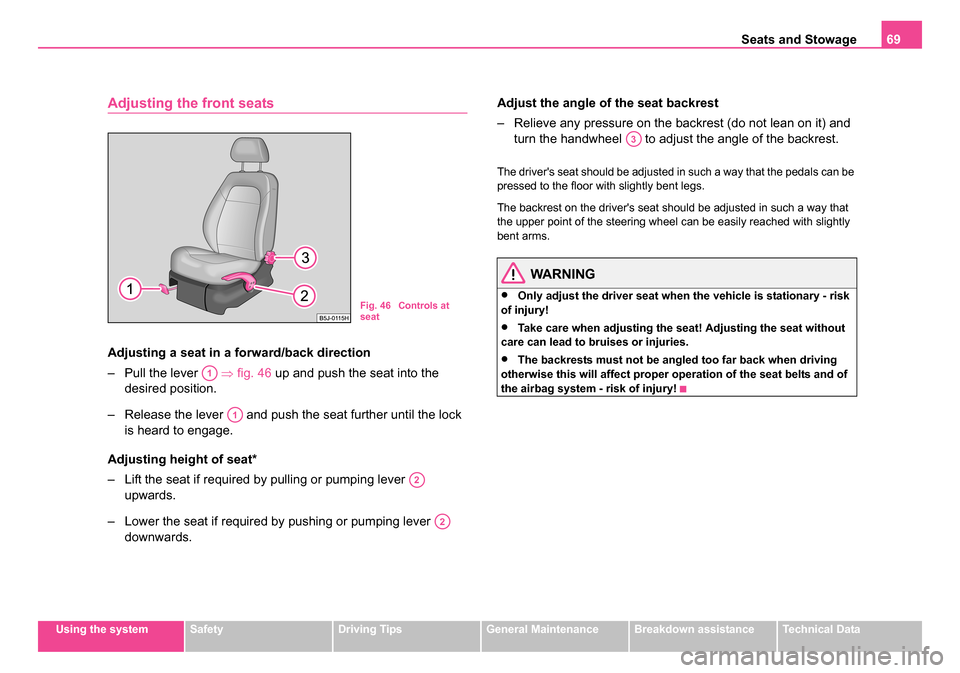
Seats and Stowage69
Using the systemSafetyDriving TipsGeneral MaintenanceBreakdown assistanceTechnical Data
Adjusting the front seats
Adjusting a seat in a forward/back direction
– Pull the lever ⇒fig. 46 up and push the seat into the
desired position.
– Release the lever and push the seat further until the lock is heard to engage.
Adjusting height of seat*
– Lift the seat if required by pulling or pumping lever upwards.
– Lower the seat if required by pushing or pumping lever downwards. Adjust the angle of
the seat backrest
– Relieve any pressure on the backrest (do not lean on it) and turn the handwheel to adjust the angle of the backrest.
The driver's seat should be adjusted in such a way that the pedals can be
pressed to the floor with slightly bent legs.
The backrest on the driver's seat should be adjusted in such a way that
the upper point of the steering wheel can be easily reached with slightly
bent arms.
WARNING
•Only adjust the driver seat when the vehicle is stationary - risk
of injury!
•Take care when adjusting the sea t! Adjusting the seat without
care can lead to bruises or injuries.
•The backrests must not be angled too far back when driving
otherwise this will affect proper operation of the seat belts and of
the airbag system - risk of injury!
Fig. 46 Controls at
seat
A1
A1
A2
A2
A3
NKO 20 A05.book Page 69 Wednesday, June 21, 2006 1:42 PM
Page 78 of 274
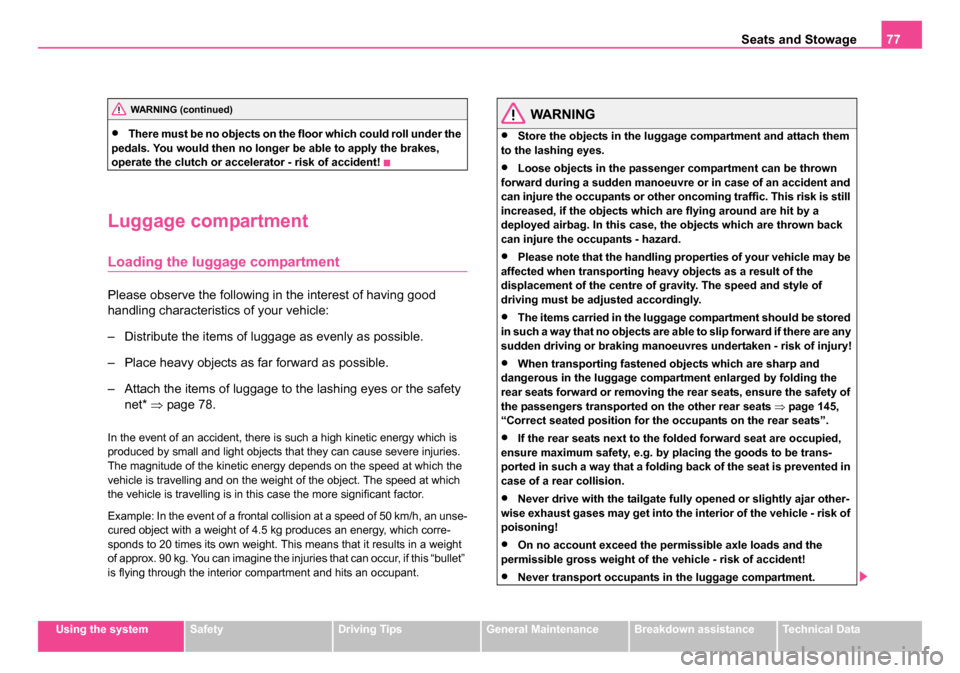
Seats and Stowage77
Using the systemSafetyDriving TipsGeneral MaintenanceBreakdown assistanceTechnical Data
•There must be no objects on the floor which could roll under the
pedals. You would then no longer be able to apply the brakes,
operate the clutch or accelerator - risk of accident!
Luggage compartment
Loading the lugg age compartment
Please observe the following in the interest of having good
handling characteristics of your vehicle:
– Distribute the items of luggage as evenly as possible.
– Place heavy objects as far forward as possible.
– Attach the items of luggage to the lashing eyes or the safety
net* ⇒page 78.
In the event of an accident, there is such a high kinetic energy which is
produced by small and light objects that they can cause severe injuries.
The magnitude of the kinetic energy depends on the speed at which the
vehicle is travelling and on the weight of the object. The speed at which
the vehicle is travelling is in this case the more significant factor.
Example: In the event of a frontal collision at a speed of 50 km/h, an unse-
cured object with a weight of 4.5 kg produces an energy, which corre-
sponds to 20 times its own weight. This means that it results in a weight
of approx. 90 kg. You can imagine the injuries that can occur, if this “bullet”
is flying through the interior compartment and hits an occupant.
WARNING
•Store the objects in the luggage compartment and attach them
to the lashing eyes.
•Loose objects in the passenger compartment can be thrown
forward during a sudden manoeuvre or in case of an accident and
can injure the occupants or other onc oming traffic. This risk is still
increased, if the objects which are flying around are hit by a
deployed airbag. In this case, the objects which are thrown back
can injure the occupants - hazard.
•Please note that the handling properties of your vehicle may be
affected when transporting heavy objects as a result of the
displacement of the centre of gravity. The speed and style of
driving must be ad justed accordingly.
•The items carried in the luggage compartment should be stored
in such a way that no objects are able to slip forward if there are any
sudden driving or braking manoeuvres undertaken - risk of injury!
•When transporting fastened objects which are sharp and
dangerous in the luggage compartment enlarged by folding the
rear seats forward or removing the rear seats, ensure the safety of
the passengers transported on the other rear seats ⇒page 145,
“Correct seated position for the occupants on the rear seats”.
•If the rear seats next to the folded forward seat are occupied,
ensure maximum safety, e.g. by placing the goods to be trans-
ported in such a way that a folding back of the seat is prevented in
case of a rear collision.
•Never drive with the tailgate fully opened or slightly ajar other-
wise exhaust gases may get into the interior of the vehicle - risk of
poisoning!
•On no account exceed the permissible axle loads and the
permissible gross weight of the vehicle - risk of accident!
•Never transport occupants in the luggage compartment.
WARNING (continued)
NKO 20 A05.book Page 77 Wednesday, June 21, 2006 1:42 PM
Page 81 of 274
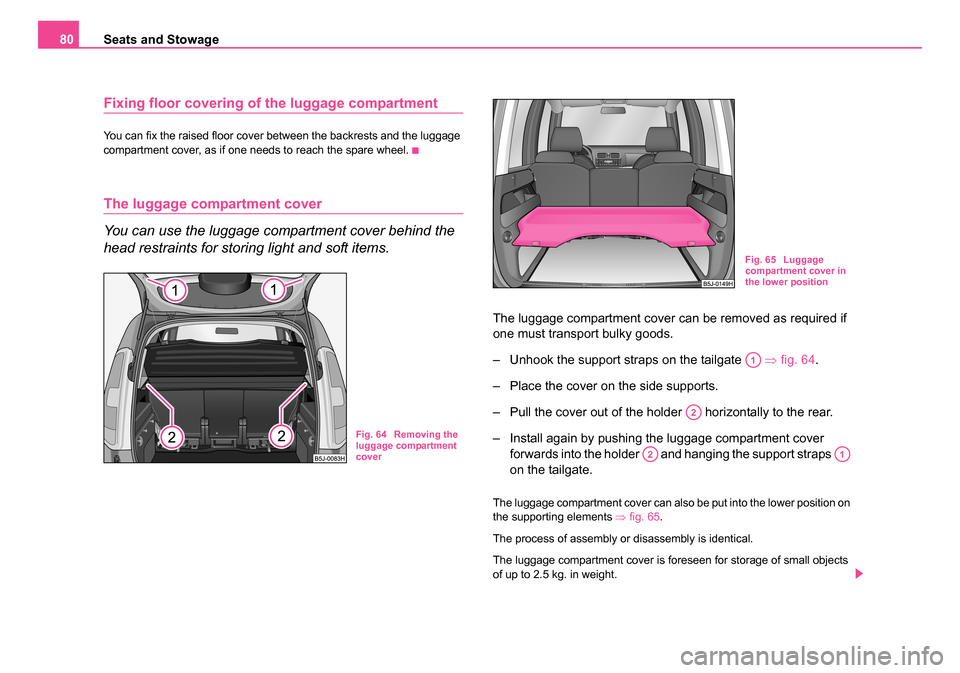
Seats and Stowage
80
Fixing floor covering of the luggage compartment
You can fix the raised floor cover between the backrests and the luggage
compartment cover, as if one needs to reach the spare wheel.
The luggage compartment cover
You can use the luggage compartment cover behind the
head restraints for storing light and soft items.
The luggage compartment cover can be removed as required if
one must transport bulky goods.
– Unhook the support straps on the tailgate ⇒fig. 64 .
– Place the cover on the side supports.
– Pull the cover out of the holder horizontally to the rear.
– Install again by pushing the luggage compartment cover forwards into the holder and hanging the support straps
on the tailgate.
The luggage compartment cover can also be put into the lower position on
the supporting elements ⇒fig. 65 .
The process of assembly or disassembly is identical.
The luggage compartment cover is foreseen for storage of small objects
of up to 2.5 kg. in weight.
Fig. 64 Removing the
luggage compartment
cover
Fig. 65 Luggage
compartment cover in
the lower position
A1
A2
A2A1
NKO 20 A05.book Page 80 Wednesday, June 21, 2006 1:42 PM
Page 82 of 274
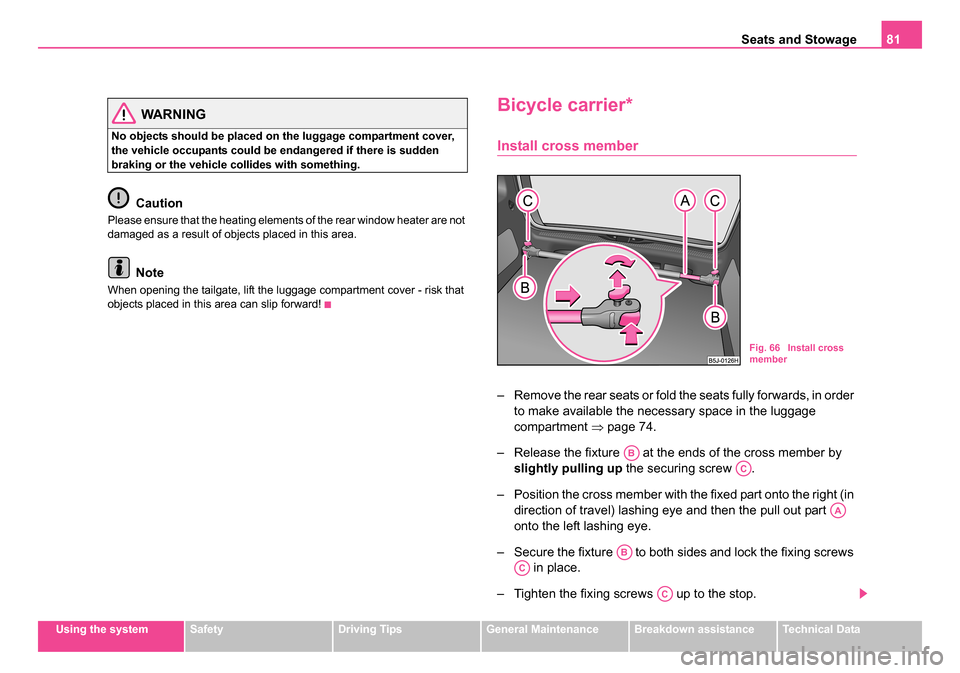
Seats and Stowage81
Using the systemSafetyDriving TipsGeneral MaintenanceBreakdown assistanceTechnical Data
WARNING
No objects should be placed on the luggage compartment cover,
the vehicle occupants could be endangered if there is sudden
braking or the vehicle co llides with something.
Caution
Please ensure that the heating elements of the rear window heater are not
damaged as a result of objects placed in this area.
Note
When opening the tailgate, lift the luggage compartment cover - risk that
objects placed in this area can slip forward!
Bicycle carrier*
Install cross member
– Remove the rear seats or fold the seats fully forwards, in order
to make available the necessary space in the luggage
compartment ⇒page 74.
– Release the fixture at the ends of the cross member by slightly pulling up the securing screw .
– Position the cross member with the fixed part onto the right (in direction of travel) lashing eye and then the pull out part
onto the left lashing eye.
– Secure the fixture to both sides and lock the fixing screws in place.
– Tighten the fixing screws up to the stop.
Fig. 66 Install cross
member
AB
AC
AA
AB
AC
AC
NKO 20 A05.book Page 81 Wednesday, June 21, 2006 1:42 PM
Page 89 of 274
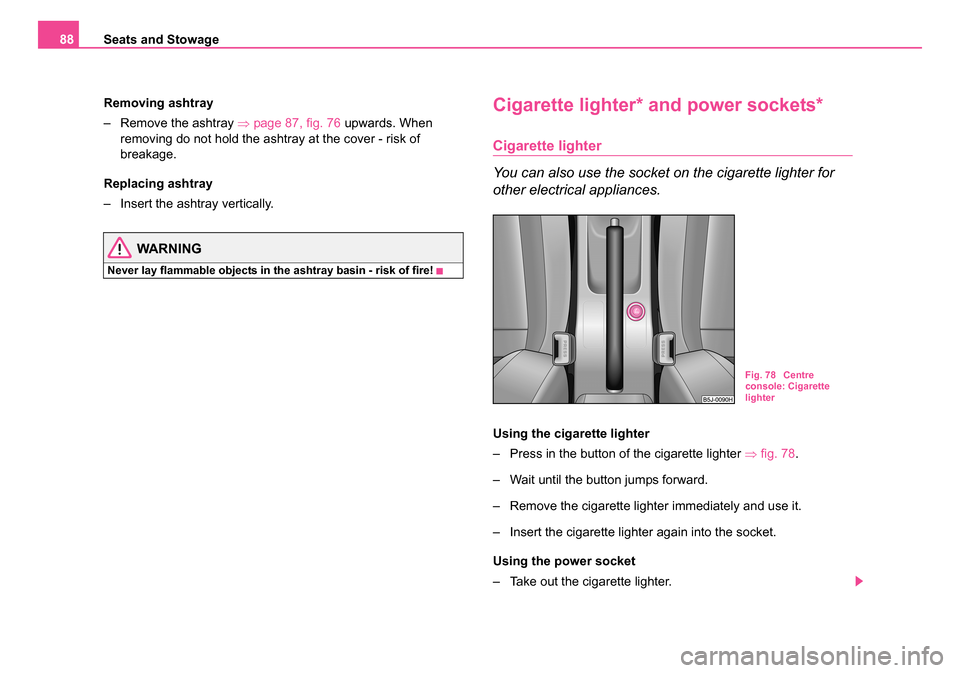
Seats and Stowage
88
Removing ashtray
– Remove the ashtray ⇒page 87, fig. 76 upwards. When
removing do not hold the ashtray at the cover - risk of
breakage.
Replacing ashtray
– Insert the ashtray vertically.
WARNING
Never lay flammable objects in the ashtray basin - risk of fire!
Cigarette lighter* and power sockets*
Cigarette lighter
You can also use the socket on the cigarette lighter for
other electrical appliances.
Using the cigarette lighter
– Press in the button of the cigarette lighter ⇒fig. 78 .
– Wait until the button jumps forward.
– Remove the cigarette lighter immediately and use it.
– Insert the cigarette lighter again into the socket.
Using the power socket
– Take out the cigarette lighter.
Fig. 78 Centre
console: Cigarette
lighter
NKO 20 A05.book Page 88 Wednesday, June 21, 2006 1:42 PM
Page 90 of 274
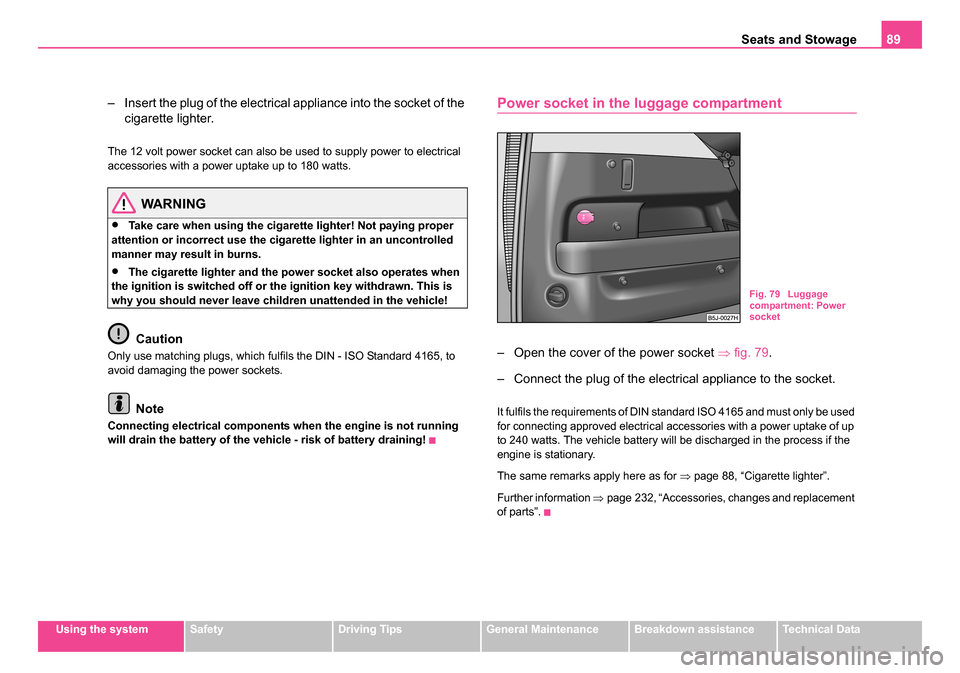
Seats and Stowage89
Using the systemSafetyDriving TipsGeneral MaintenanceBreakdown assistanceTechnical Data
– Insert the plug of the electrical appliance into the socket of the
cigarette lighter.
The 12 volt power socket can also be used to supply power to electrical
accessories with a power uptake up to 180 watts.
WARNING
•Take care when using the cigarette lighter! Not paying proper
attention or incorrect use the cigarette lighter in an uncontrolled
manner may result in burns.
•The cigarette lighter and the power socket also operates when
the ignition is switched off or th e ignition key withdrawn. This is
why you should never leave children unattended in the vehicle!
Caution
Only use matching plugs, which fulfils the DIN - ISO Standard 4165, to
avoid damaging the power sockets.
Note
Connecting electrical components when the engine is not running
will drain the battery of the vehicle - risk of battery draining!
Power socket in the luggage compartment
– Open the cover of the power socket ⇒fig. 79 .
– Connect the plug of the electrical appliance to the socket.
It fulfils the requirements of DIN standard ISO 4165 and must only be used
for connecting approved electrical accessories with a power uptake of up
to 240 watts. The vehicle battery will be discharged in the process if the
engine is stationary.
The same remarks apply here as for ⇒page 88, “Cigarette lighter”.
Further information ⇒page 232, “Accessories, changes and replacement
of parts”.
Fig. 79 Luggage
compartment: Power
socket
NKO 20 A05.book Page 89 Wednesday, June 21, 2006 1:42 PM
Page 96 of 274
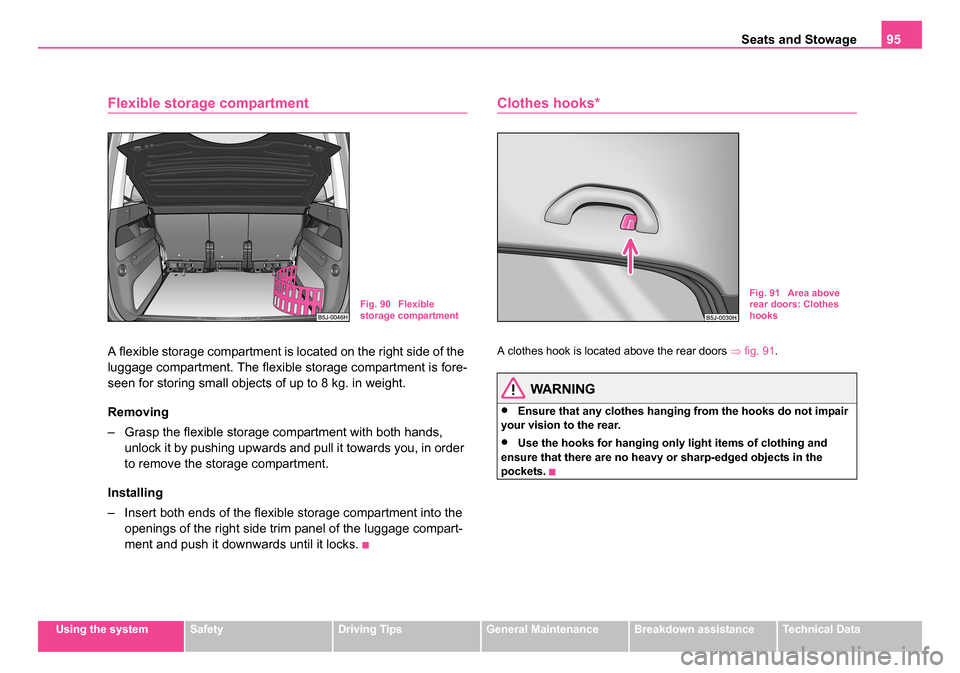
Seats and Stowage95
Using the systemSafetyDriving TipsGeneral MaintenanceBreakdown assistanceTechnical Data
Flexible storage compartment
A flexible storage compartment is located on the right side of the
luggage compartment. The flexible storage compartment is fore-
seen for storing small objects of up to 8 kg. in weight.
Removing
– Grasp the flexible storage compartment with both hands,
unlock it by pushing upwards and pull it towards you, in order
to remove the storage compartment.
Installing
– Insert both ends of the flexible storage compartment into the openings of the right side trim panel of the luggage compart-
ment and push it downwards until it locks.
Clothes hooks*
A clothes hook is located above the rear doors ⇒fig. 91 .
WARNING
•Ensure that any clothes hanging from the hooks do not impair
your vision to the rear.
•Use the hooks for hanging only light items of clothing and
ensure that there are no heavy or sharp-edged objects in the
pockets.
Fig. 90 Flexible
storage compartmentFig. 91 Area above
rear doors: Clothes
hooks
NKO 20 A05.book Page 95 Wednesday, June 21, 2006 1:42 PM
Page 99 of 274
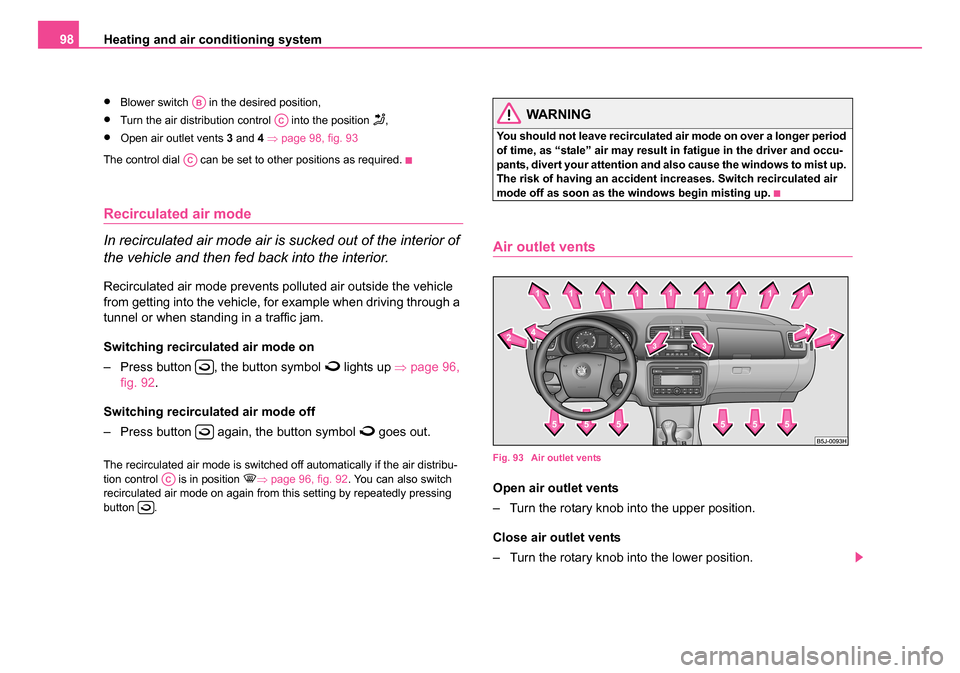
Heating and air conditioning system
98
•Blower switch in the desired position,
•Turn the air distribution control into the position ,
•Open air outlet vents 3 and 4 ⇒ page 98, fig. 93
The control dial can be set to other positions as required.
Recirculated air mode
In recirculated air mode air is sucked out of the interior of
the vehicle and then fed back into the interior.
Recirculated air mode prevents polluted air outside the vehicle
from getting into the vehicle, for example when driving through a
tunnel or when standing in a traffic jam.
Switching recircul ated air mode on
– Press button , the button symbol
lights up ⇒page 96,
fig. 92 .
Switching recirculat ed air mode off
– Press button again, the button symbol
goes out.
The recirculated air mode is switched off automatically if the air distribu-
tion control is in position ⇒ page 96, fig. 92 . You can also switch
recirculated air mode on again from this setting by repeatedly pressing
button .
WARNING
You should not leave recirculated air mode on over a longer period
of time, as “stale” air may result in fatigue in the driver and occu-
pants, divert your attention and al so cause the windows to mist up.
The risk of having an accident increases. Switch recirculated air
mode off as soon as the windows begin misting up.
Air outlet vents
Fig. 93 Air outlet vents
Open air outlet vents
– Turn the rotary knob into the upper position.
Close air outlet vents
– Turn the rotary knob into the lower position.
AB
AC
AC
AC
NKO 20 A05.book Page 98 Wednesday, June 21, 2006 1:42 PM